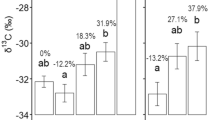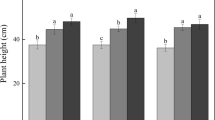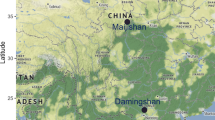Abstract
Invasive plants can impact nutrient cycling, potentially creating positive feedbacks for further invasion. We studied the impact of three woody nitrogen (N)-fixing invasive plant species on soil N-cycling and phosphatase activity in a montane tropical forest-grassland mosaic in the Nilgiri Biosphere Reserve in southern India, an ecosystem with > 100-year history of biological invasions. Soils were collected over a year from patches invaded by Acacia mearnsii, Cytisus scoparius, and Ulex europaeus, and from uninvaded grasslands, to assess inorganic N-availability and N-mineralization rates (using in situ open-top mineralization tubes). Phosphatase activity was measured from soils collected at the beginning of the growing season. Soils of invaded areas had higher inorganic N-availability and phosphatase activity than soils of uninvaded areas. Whilst net N-mineralization rates were unchanged between invaded and uninvaded sites, net nitrification rates were higher and net ammonification rates lower in invaded areas, particularly in the dry season. Impacts of C. scoparius and U. europaeus on these variables were similar to each other, and lower than the impacts of A. mearnsii. These results show that invasive N-fixers are significantly altering nutrient availability and cycling, and also changing the proportion of the forms of inorganic N available, in the Nilgiri grasslands. Restoration activities in these invaded grasslands should explore soil N management strategies such as soil C amendments and planting of specific native species, in conjunction with other strategies, to control invasive plants.





Similar content being viewed by others
Data availability
The datasets generated during and/or analysed during the current study are available in electronic form in the attached zip “Supplementary_Data.zip”.
Code availability
All analysis was done in the R programming environment using openly available functions.
References
Andersen KM, Mayor JR, Turner BL (2017) Plasticity in nitrogen uptake among plant species with contrasting nutrient acquisition strategies in a tropical forest. Ecology 98(5):1388–1398. https://doi.org/10.1002/ecy.1793
Appel T (1998) Non-biomass soil organic N—the substrate for N mineralization flushes following soil drying–rewetting and for organic N rendered CaCl2-extractable upon soil drying. Soil Biol Biochem 30(10–11):1445–1456. https://doi.org/10.1016/S0038-0717(97)00230-7
Arasumani M, Khan D, Vishnudas CK et al (2019) Invasion compounds an ecosystem-wide loss to afforestation in the tropical grasslands of the Shola Sky Islands. Biol Conserv 230:141–150. https://doi.org/10.1016/j.biocon.2018.12.019
Augustine DJ, McNaughton SJ (2004) Temporal asynchrony in soil nutrient dynamics and plant production in a semiarid ecosystem. Ecosystems 7(8):829–840. https://doi.org/10.1007/s10021-004-0253-1
Bateman JB, Vitousek PM (2018) Soil fertility response to Ulex europaeus invasion and restoration efforts. Biol Invas 20(10):2777–2791. https://doi.org/10.1007/s10530-018-1729-9
Boudsocq S, Niboyet A, Lata JC et al (2012) Plant preference for ammonium versus nitrate: a neglected determinant of ecosystem functioning? Am Nat 180(1):60–69. https://doi.org/10.1086/665997
Bunyan M, Bardhan S, Jose S (2012) The shola (tropical montane forest)-grassland ecosystem mosaic of peninsular India: a review. AJPS 3(11):1632–1639. https://doi.org/10.4236/ajps.2012.311198
Byers JE, Reichard S, Randall JM et al (2002) Directing research to reduce the impacts of nonindigenous species. Conserv Biol 16(3):630–640. https://doi.org/10.1046/j.1523-1739.2002.01057.x
Caner L, Bourgeon G, Toutain F et al (2000) Characteristics of non-allophanic andisols derived from low activity clay regoliths in Nilgiri hills (Southern India). Eur J Soil Sci 51(4):553–563. https://doi.org/10.1111/j.1365-2389.2000.00344.x
Carreiro MM, Sinsabaugh RL, Repert DA et al (2000) Microbial enzyme shifts explain litter decay responses to simulated nitrogen deposition. Ecology 81(9):2359–2365. https://doi.org/10.1890/0012-9658(2000)081[2359:MESELD]2.0.CO;2
Castro-Díez P, Godoy O, Alonso A et al (2014) What explains variation in the impacts of exotic plant invasions on the nitrogen cycle? A meta-analysis. Ecol Lett 17(1):1–12. https://doi.org/10.1111/ele.12197
Cordero RL, Torchelsen FP, Overbeck GE et al (2016) Invasive gorse (Ulex europaeus, Fabaceae) changes plant community structure in subtropical forest–grassland mosaics of southern Brazil. Biol Invas 18(6):1629–1643. https://doi.org/10.1007/s10530-016-1106-5
Funk JL (2013) The physiology of invasive plants in low-resource environments. Conserv Physiol 1(1):1–17. https://doi.org/10.1093/conphys/cot026
Grove S, Parker IM, Haubensak KA (2015) Persistence of a soil legacy following removal of a nitrogen-fixing invader. Biol Invas 17(9):2621–2631. https://doi.org/10.1007/s10530-015-0900-9
Hacker RB, Toole ID, Melville GJ et al (2017) Managing competitive interactions to promote regeneration of native perennial grasses in semi-arid south-eastern Australia. Rangel J 39(1):59–71. https://doi.org/10.1071/RJ16048
Hanselman TA, Graetz DA, Obreza TA (2004) A comparison of in situ methods for measuring net nitrogen mineralization rates of organic soil amendments. J Environ Qual 33(3):1098–1105. https://doi.org/10.2134/jeq2004.1098
Haubensak KA, Parker IM (2004) Soil changes accompanying invasion of the exotic shrub Cytisus scoparius in glacial outwash prairies of western Washington [USA]. Plant Ecol 175(1):71–79. https://doi.org/10.1023/B:VEGE.0000048088.32708.58
Jo I, Fridley JD, Frank DA (2017) Invasive plants accelerate nitrogen cycling: evidence from experimental woody monocultures. J Ecol 105(4):1105–1110. https://doi.org/10.1111/1365-2745.12732
Jones RO, Chambers JC, Board DI et al (2015) The role of resource limitation in restoration of sagebrush ecosystems dominated by cheatgrass (Bromus tectorum). Ecosphere 6(7):1–21. https://doi.org/10.1890/ES14-00285.1
Joshi AA, Sankaran M, Ratnam J (2018a) ‘Foresting’ the grassland: historical management legacies in forest-grassland mosaics in southern India, and lessons for the conservation of tropical grassy biomes. Biol Conserv 224:144–152. https://doi.org/10.1016/j.biocon.2018.05.029
Joshi AA, Sankaran M, Ratnam J (2018b) Climate and vegetation collectively drive soil respiration in montane forest-grassland landscapes of the southern Western Ghats, India. BioRxiv 5:81. https://doi.org/10.1101/486324
Joshi AA, Ratnam J, Sankaran M (2019) Frost maintains forests and grasslands as alternate states in a montane tropical forest–grassland mosaic; but alien tree invasion and warming can disrupt this balance. J Ecol 108(1):122–132. https://doi.org/10.1111/1365-2745.13239
Khanna PK, Raison RJ (2013) In situ core methods for estimating soil mineral-N fluxes: re-evaluation based on 25 years of application and experience. Soil Biol Biochem 64:203–210. https://doi.org/10.1016/j.soilbio.2012.09.004
Krishna Kumar N, Udayan PS, Subramani SP et al (2013) Flowering plants of sholas and grasslands of the Nilgiris. Institute of Forest Genetics and Tree Breeding, Coimbatore
Krom MD (1980) Spectrophotometric determination of ammonia: a study of a modified Berthelot reaction using salicylate and dichloroisocyanurate. Analyst 105(1249):305–316. https://doi.org/10.1039/AN9800500305
Lata J-C, Degrange V, Raynaud X et al (2004) Grass populations control nitrification in savanna soils. Funct Ecol 18(4):605–611. https://doi.org/10.1111/j.0269-8463.2004.00880.x
Le Maitre DC, Gaertner M, Marchante E et al (2011) Impacts of invasive Australian acacias: implications for management and restoration. Divers Distrib 17(5):1015–1029. https://doi.org/10.1111/j.1472-4642.2011.00816.x
Le Roux JJ, Ellis AG, van Zyl LM et al (2018) Importance of soil legacy effects and successful mutualistic interactions during Australian acacia invasions in nutrient-poor environments. J Ecol 106(5):2071–2081. https://doi.org/10.1111/1365-2745.12965
Lenth RV (2016) Least-squares means: the R package lsmeans. J Stat Softw 69(1):33. https://doi.org/10.18637/jss.v069.i01
Li KY, Zhao YY, Yuan XL et al (2012) Comparison of factors affecting soil nitrate nitrogen and ammonium nitrogen extraction. Commun Soil Sci Plan 43(3):571–588. https://doi.org/10.1080/00103624.2012.639108
Lodge DJ, McDowell WH, McSwiney CP (1994) The importance of nutrient pulses in tropical forests. Trends Ecol Evol 9(10):384–387. https://doi.org/10.1016/0169-5347(94)90060-4
Mason NWH, Mudge PL, Palmer D et al (2016) Catchment-scale contribution of invasive nitrogen fixing shrubs to nitrate leaching: a sco** study. J R Soc N Z 46(2):85–102. https://doi.org/10.1080/03036758.2015.1127261
Oms MT, Cerdi A, Cerdi V (1995) Sequential injection analysis of nitrites and nitrates. Anal Chim Acta 315(3):321–330. https://doi.org/10.1016/0003-2670(95)00316-R
Orwa C, Mutua A, Kindt R et al (2009) Agroforestree database: a tree reference and selection guide version 4.0. World Agroforestry Centre, Nairobi
Paulsamy S, Kil B-S, Sivashanmugam M (2012) Matter dynamics with respect to influences of C3 and C4 plants in four subtropical grasslands of Nilgiri Biosphere Reserve, the Western Ghats, India. J Ecol Environ 35(4):259–267. https://doi.org/10.5141/JEFB.2012.030
Perry LG, Blumenthal DM, Monaco TA et al (2010) Immobilizing nitrogen to control plant invasion. Oecologia 163(1):13–24. https://doi.org/10.1007/s00442-010-1580-x
Pinheiro J, Bates D, DebRoy S, et al. (2019) nlme: linear and nonlinear mixed effects models. R package version 3.1-141. https://CRAN.R-project.org/package=nlme
Pyšek P, Jarošík V, Hulme PE et al (2012) A global assessment of invasive plant impacts on resident species, communities and ecosystems: the interaction of impact measures, invading species’ traits and environment. Glob Change Biol 18(5):1725–1737. https://doi.org/10.1111/j.1365-2486.2011.02636.x
R Core Team (2018) R: a language and environment for statistical computing. R Foundation for Statistical Computing, Vienna, Austria. https://www.R-project.org/
Richardson DM, Allsopp N, D’Antonio CM et al (2000) Plant invasions—the role of mutualisms. Biol Rev 75(1):65–93. https://doi.org/10.1017/S0006323199005435
Sankaran M (2016) Grazing and fire effects on community and ecosystem processes in a tall-grass mesic savanna ecosystem in southern India. In: Ahrestani FS, Sankaran M (eds) The ecology of large herbivores in south and southeast Asia. Springer, Dordrecht, pp 187–205
Sardans J, Bartrons M, Margalef O et al (2017) Plant invasion is associated with higher plant–soil nutrient concentrations in nutrient-poor environments. Glob Change Biol 23(3):1282–1291. https://doi.org/10.1111/gcb.13384
Sikka AK, Samra JS, Sharda VN et al (2003) Low flow and high flow responses to converting natural grassland into bluegum (Eucalyptus globulus) in Nilgiris watersheds of South India. J Hydrol 270(1–2):12–26. https://doi.org/10.1016/S0022-1694(02)00172-5
Sinsabaugh RL, Linkins AE (1990) Enzymic and chemical analysis of particulate organic matter from a boreal river. Freshw Biol 23(2):301–309. https://doi.org/10.1111/j.1365-2427.1990.tb00273.x
Srinivasan MP (2011) The ecology of disturbances and global change in the montane grasslands of the Nilgiris, South India. PhD thesis. University of Kentucky, Lexington, Kentucky
Srinivasan MP, Gleeson SK, Arthur MA (2012) Short-term impacts of nitrogen fertilization on a montane grassland ecosystem in a South Asian biodiversity hotspot. Plant Ecol Divers 5(3):289–299. https://doi.org/10.1080/17550874.2012.727486
Sriramamurthy RT, Bhalla RS, Sankaran M (2020) Fire differentially affects mortality and seedling regeneration of three woody invaders in forest–grassland mosaics of the southern Western Ghats, India. Biol Invas 22:1623–1634. https://doi.org/10.1007/s10530-020-02207-7
Srivastava RK (2002) India: Invasion of exotic weeds in the natural forests of tropical India due to forest fire-a threat to biodiversity. Int for Fire News 27:90–92
Stewart SD, Young MB, Harding JS et al (2019) Invasive nitrogen-fixing plant amplifies terrestrial–aquatic nutrient flow and alters ecosystem function. Ecosystems 22(3):587–601. https://doi.org/10.1007/s10021-018-0289-2
Sukumar R, Ramesh R, Pant RK et al (1993) A δ13C record of late quaternary climate change from tropical peats in southern India. Nature 364(6439):703–706. https://doi.org/10.1038/364703a0
Tabatabai MA, Bremner JM (1969) Use of p-nitrophenyl phosphate for assay of soil phosphatase activity. Soil Biol Biochem 1(4):301–307. https://doi.org/10.1016/0038-0717(69)90012-1
Thomas S, Palmer M (2007) The montane grasslands of the Western Ghats, India: community ecology and conservation. Community Ecol 8(1):67–73. https://doi.org/10.1556/ComEc.8.2007.1.9
Tilman D (1987) Secondary succession and the pattern of plant dominance along experimental nitrogen gradients. Ecol Monogr 57(3):189–214. https://doi.org/10.2307/2937080
Unkule M (2017) Effect of removal of an invasive species, Acacia mearnsii on the plant diversity in a Shola-grassland ecosystem. MSc thesis. Indian Institute of Science Education and Research, Pune, India
Vasquez E, Sheley R, Svejcar T (2008) Creating invasion resistant soils via nitrogen management. Invas Plant Sci Manage 1(3):304–314. https://doi.org/10.1614/IPSM-07-059.1
Vitousek PM, Walker LR (1989) Biological invasion by Myrica faya in Hawai’i: plant demography, nitrogen fixation, ecosystem effects. Ecol Monogr 59(3):247–265. https://doi.org/10.2307/1942601
Vitousek PM, Menge DN, Reed SC et al (2013) Biological nitrogen fixation: rates, patterns and ecological controls in terrestrial ecosystems. Philos Trans R Soc B 368(1621):20130119. https://doi.org/10.1098/rstb.2013.0119
Wearne LJ, Morgan JW (2004) Community-level changes in Australian subalpine vegetation following invasion by the non-native shrub Cytisus scoparius. J Veg Sci 15(5):595–604. https://doi.org/10.1111/j.1654-1103.2004.tb02301.x
**ao H, Schaefer DA, Yang X (2017) pH drives ammonia oxidizing bacteria rather than archaea thereby stimulate nitrification under Ageratina adenophora colonization. Soil Biol Biochem 114:12–19. https://doi.org/10.1016/j.soilbio.2017.06.024
Yapi TS, O’Farrell PJ, Dziba LE et al (2018) Alien tree invasion into a South African montane grassland ecosystem: impact of Acacia species on rangeland condition and livestock carrying capacity. Int J Biodivers Sci, Ecosyst Serv Manage 14(1):105–116. https://doi.org/10.1080/21513732.2018.1450291
Yelenik SG, Stock WD, Richardson DM (2004) Ecosystem level impacts of invasive Acacia saligna in the South African fynbos. Restor Ecol 12(1):44–51. https://doi.org/10.1111/j.1061-2971.2004.00289.x
Yelenik SG, D’Antonio CM (2013) Self-reinforcing impacts of plant invasions change over time. Nature 503(7477):517. https://doi.org/10.1038/nature12798
Zhao M, Lu X, Zhao H et al (2019) Ageratina adenophora invasions are associated with microbially mediated differences in biogeochemical cycles. Sci Total Environ 677:47–56. https://doi.org/10.1016/j.scitotenv.2019.04.330
Zhou Y, Staver AC (2019) Enhanced activity of soil nutrient-releasing enzymes after plant invasion: a meta-analysis. Ecology 100(11):e02830. https://doi.org/10.1002/ecy.2830
Zuur AF, Ieno EN, Walker N et al (2009) Mixed effects models and extensions in ecology with R. Springer, New York
Acknowledgments
We thank Tamil Nadu Forest Department for permits to conduct this project in the Nilgiris Forest Division, and the Tamil Nadu Electricity Board for providing us with residential quarters during this project. We are grateful to Atul Joshi, Balavignesh Baliah, Chandan Pandey, Chintan Sheth, Dayani C, Joyshree Chanam, Kaikho D, Karthik Teegalapalli, Manjunatha H Chandregowda, Rajat Rastogi, Rasikapriyaa Sriramamurthy, Sandeep Pulla, Shashank Ongole, Yadugiri V T for their insights in different phases of the project and comments on the manuscript. We thank Dr. Jayashree Ratnam and Dr. Deepak Barua for their comments during the initial stages of the project. We thank Selva, Susilan, Kamal, and Saravanan who provided invaluable assistance with fieldwork throughout the project. We also thank the anonymous reviewers for their comments on the manuscript. National Centre for Biological Sciences, Bengaluru, provided core funding for this study.
Funding
This work was supported by the National Centre for Biological Sciences, Tata Institute of Fundamental Research, Bengaluru, by the Department of Atomic Energy, Government of India [Grant Number 12-R&D-TFR-5.04-0800]. Manaswi Raghurama was awarded an intra-mural travel Grant by National Centre for Biological Sciences to attend, and present the results of this study, in the 18th International Savanna Science Network Meeting, Kruger National Park, South Africa.
Author information
Authors and Affiliations
Contributions
Both authors contributed to the study conception and design, and statistical analysis. Sample collection and analysis was performed by Manaswi Raghurama. First draft of the manuscript was written by Manaswi Raghurama and both authors commented on previous versions of the manuscript. Both authors read and approved the final manuscript.
Corresponding author
Ethics declarations
Conflict of interest
The author declare that they have no conflict of interest.
Additional information
Communicated by Rodolfo Gentili.
Publisher's Note
Springer Nature remains neutral with regard to jurisdictional claims in published maps and institutional affiliations.
Supplementary Information
Below is the link to the electronic supplementary material.
Rights and permissions
About this article
Cite this article
Raghurama, M., Sankaran, M. Invasive nitrogen-fixing plants increase nitrogen availability and cycling rates in a montane tropical grassland. Plant Ecol 223, 13–26 (2022). https://doi.org/10.1007/s11258-021-01188-4
Received:
Accepted:
Published:
Issue Date:
DOI: https://doi.org/10.1007/s11258-021-01188-4




